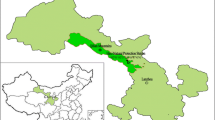Abstract
We investigated the effects of warming the basal ends of Carolina poplar (Populus × canadensis Moench.) softwood cuttings at controlled low-air-temperature on their root growth and leaf damage after planting. The warming treatment was applied to the cuttings by soaking 10 mm beyond the cut end in warmed water maintained at 30 °C in a cold chamber maintained at an air temperature of 10 °C and a photosynthetic photon flux density (PPFD) of 10 μmol m−2 s−1 (near the light compensation point at 10 °C) until rooting was observed. The warmed cuttings were then grown in a growth chamber at an air temperature of 30 °C, relative humidity 85–90 %, and a PPFD of 100 μmol m−2 s−1. Control cuttings were grown in the growth chamber throughout the experiment. Rooting occurred simultaneously for both warmed and control cuttings, irrespective of air temperature. Root development was greater and leaf damage, evaluated on the basis of extent of necrosis, was less for warmed cuttings than for control cuttings. The reduction of leaf damage for warmed cuttings probably resulted from reduced post-planting water stress and leaf senescence, because of improved root development as a result of the pre-planting warming treatment. This technique could improve the propagation of cuttings of woody plants, because it would ensure that the cuttings are ready to develop roots with minimum loss of carbohydrates, irrespective of weather conditions.




Similar content being viewed by others
References
Confalonieri M, Balestrazzi A, Bisoffi S, Carbonera D (2003) In vitro culture and genetic engineering of Populus spp.: synergy for forest tree improvement. Plant Cell Tissue Organ Cult 72:109–138
Desrochers A, Thomas BR (2003) A comparison of pre-planting treatments on hardwood cuttings of four hybrid poplar clones. New For 26:17–32
De Luca d'Oro GM, Trippi VS (1987) Effect of stress conditions induced by temperature, water and rain on senescence development. Plant Cell Physiol 28:1389–1396
Druege U, Kadner R (2008) Response of post-storage carbohydrate levels in Pelargonium cuttings to reduced air temperature during rooting and the relationship with leaf senescence and adventitious root formation. Postharvest Biol Technol 47:126–135
Garten CT, Wullschleger SD, Classen AT (2011) Review and model-based analysis of factors influencing soil carbon sequestration under hybrid poplar. Biomass Bioenergy 35:214–226
Hartmann HT, Kester DE, Davies FT Jr, Geneve RL (2002) Plant propagation, 7th edn. Pearson Education, Upper Saddle River 880
Heilman PE (1999) Planted forests: poplars. New For 17:89–93
Jouve L, Franck T, Gaspar T, Cattivelli L, Hausman JF (2000) Poplar acclimation to cold during in vitro conservation at low non-freezing temperature: metabolic and proteic changes. J Plant Physiol 157:117–123
Liberloo M, Calfapietra C, Lukac M, Godbold D, Luo ZB, Polle A, Hoosbeck MR, Ceulemans R (2006) Woody biomass production during the second rotation of a bio-energy Populus plantation increases in a future high CO2 world. Glob Change Biol 12:1094–1106
Macdonald B (1986) Practical woody plant propagation for nursery growers. Timber Press, Portland
Petersen LA, Phipps HM (1976) Water soaking pretreatment improves rooting and early survival of hardwood cuttings of some Populus clones. Tree Plant Note 27:12–22
Puri S, Thompson FB (2003a) Relationship of water to adventitious rooting in stem cuttings of Populus species. Agrofor Syst 58:1–9
Puri S, Thompson FB (2003b) Effect of soil and plant water relations on rooting of Populus × euramericana stem cuttings. New For 25:109–124
Shibuya T, Tokuda A, Terakura R, Shimizu-Maruo K, Sugiwaki H, Kitaya Y, Kiyota M (2007) Short-term bottom-heat treatment during low-air-temperature storage improves rooting in squash (Cucurbita moschata Duch.) cuttings used for rootstock of cucumber (Cucumis sativus L.). J Jpn Soc Hortic Sci 76:139–143
Sitton D, Itai C, Kende H (1967) Decreased cytokinin production in the roots as a factor in shoot senescence. Planta 73:296–300
Stenvall N, Haapala T, Aarlahti S, Pulkkinen P (2005) The effect of soil temperature and light on sprouting and rooting of root cuttings of hybrid aspen clones. Can J For Res 35:2671–2678
Acknowledgments
This study was supported by the Japan Society for the Promotion of Science (JSPS Grant-in-Aid for Scientific Research (B) (General), 21380157) from 2009 to 2011, and by a research grant from the Iwatani Naoji Foundation in 2009. The authors are grateful to Ms Tomoko Morioka for her technical assistance and to Dr Makoto Kiyota for frequent and valuable discussions.
Author information
Authors and Affiliations
Corresponding author
About this article
Cite this article
Shibuya, T., Tsukuda, S., Tokuda, A. et al. Effects of warming basal ends of Carolina poplar (Populus × canadensis Moench.) softwood cuttings at controlled low-air-temperature on their root growth and leaf damage after planting. J For Res 18, 279–284 (2013). https://doi.org/10.1007/s10310-012-0343-4
Received:
Accepted:
Published:
Issue Date:
DOI: https://doi.org/10.1007/s10310-012-0343-4




